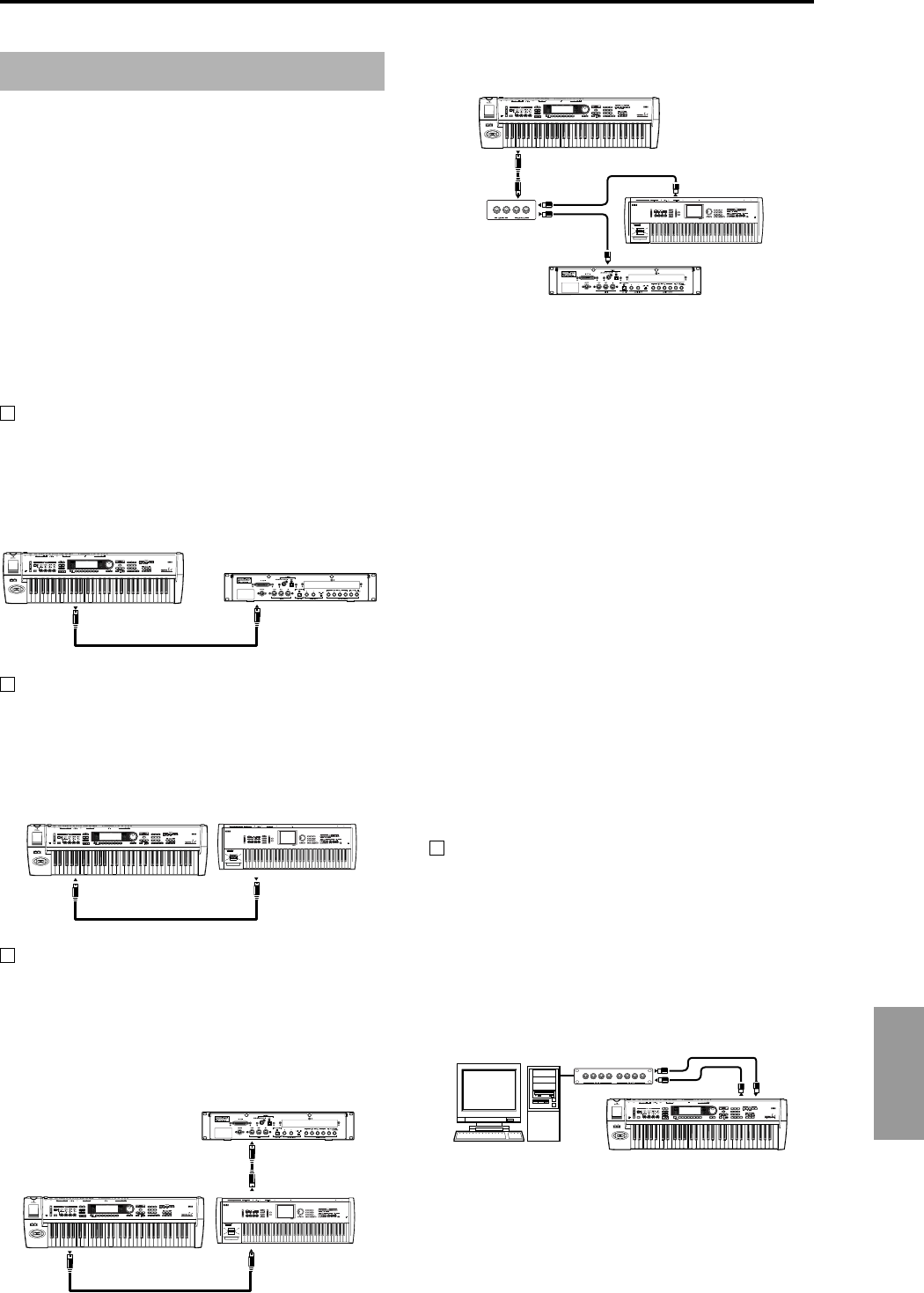
231
Appendices
■ About MIDI
MIDI stands for Musical Instrument Digital Interface, and is
a world-wide standard for exchanging various types of
musical data between electronic musical instruments and
computers. When MIDI cables are used to connect two or
more MIDI devices, performance data can be exchanged
between the devices, even if they were made by different
manufacturers.
■ Connecting MIDI devices/computers
(MIDI connectors)
Controlling an external MIDI tone generator
from this instrument
When you wish to use the TRITON Le’s keyboard, control-
lers, and sequencer etc. to play an external MIDI tone gener-
ator, use a MIDI cable to connect this instrument’s MIDI
OUT connector to the MIDI IN connector of the external
MIDI tone generator.
Controlling this instrument’s tone generator
from an external MIDI device
When you wish to play or control the TRITON Le’s tone
generator from an external MIDI keyboard or sequencer etc.,
use a MIDI cable to connect the MIDI OUT connector of the
external MIDI device to the MIDI IN connector of this
instrument.
Controlling two or more external MIDI tone
generators from this instrument
You can use the MIDI THRU jack to simultaneously control
multiple MIDI devices. (This type of connection should be
used to connect no more than three devices. If you wish to
connect a larger number of MIDI devices, we recommend
that you use a MIDI patch bay as shown in the second dia-
gram below.)
You can also use a MIDI patch bay to control multiple MIDI
devices.
The “Convert Position” setting
On the TRITON Le, the parameters “Key Transpose,”
“Velocity Curve” and “AfterT Curve” (GLOBAL 1.1–1a)
allow you to transpose the pitch, adjust the velocity sensitiv-
ity, and adjust the after touch sensitivity (☞p.122).
The effect that these settings will have on the internal
sequencer and on the MIDI data that is transmitted and
received will depend on “Convert Position” (GLOBAL 2.1–
1a) setting (☞p.127).
•When controlling an external MIDI tone generator from
the TRITON Le, select Pre MIDI. The above-listed
settings will affect the MIDI data that is transmitted.
These settings will also affect the data that is recorded on
the internal sequencer.
Incoming MIDI data will be handled with settings equiv-
alent to “Key Transpose” 0, “Velocity Curve” 4, and
“AfterT Curve” 3.
•When controlling the TRITON Le’s tone generator from
an external MIDI device, select PostMIDI. The above-
listed settings will affect the MIDI data that is received.
These settings will also affect the data that is played back
from the internal sequencer.
Outgoing MIDI data will be handled with settings equiv-
alent to “Key Transpose” 0, “Velocity Curve” 4, and
“AfterT Curve” 3.
Connecting an external MIDI sequencer or
computer etc.
You can play the TRITON Le’s keyboard and record your
performance on an external MIDI sequencer/computer
(connected via a MIDI interface), and then play back the
recorded performance to sound the TRITON Le’s tone gen-
erator (i.e., using this instrument as an input keyboard and
MIDI tone generator). To do this, connect the MIDI OUT and
MIDI IN connectors of the TRITON Le and your external
MIDI sequencer/computer to each other.
Local Control On settings
When connections are made as shown above, turn on the
Echo Back function of the external MIDI sequencer or com-
puter (so that data received at MIDI IN will be re-transmit-
ted from MIDI OUT), and turn off the TRITON Le’s Local
Control setting (so that this instrument’s keyboard and tone
MIDI applications
MIDI OUT TRITON Le
MIDI tone generatorMIDI IN
MIDI IN TRITON Le
MIDI OUT
MIDI keyboard
MIDI OUT TRITON Le
MIDI IN
MIDI THRU
MIDI keyboard
MIDI tone generator
MIDI IN
MIDI IN
MIDI OUT
MIDI IN
MIDI OUT
MIDI keyboard
MIDI tone generator
MIDI patch bay
TRITON Le
MIDI IN
MIDI OUT
computer
MIDI IN
TRITON Le
MIDI interface
MIDI INMIDI OUT
MIDI OUT
